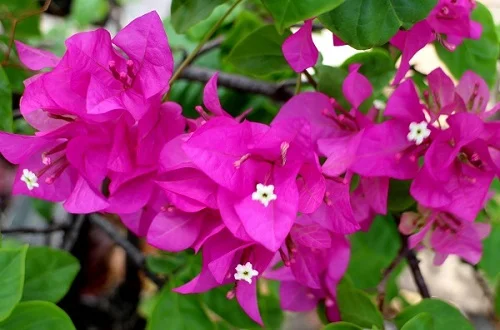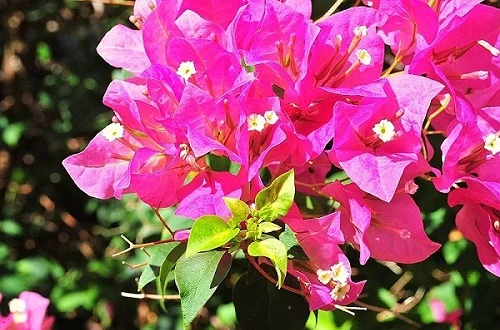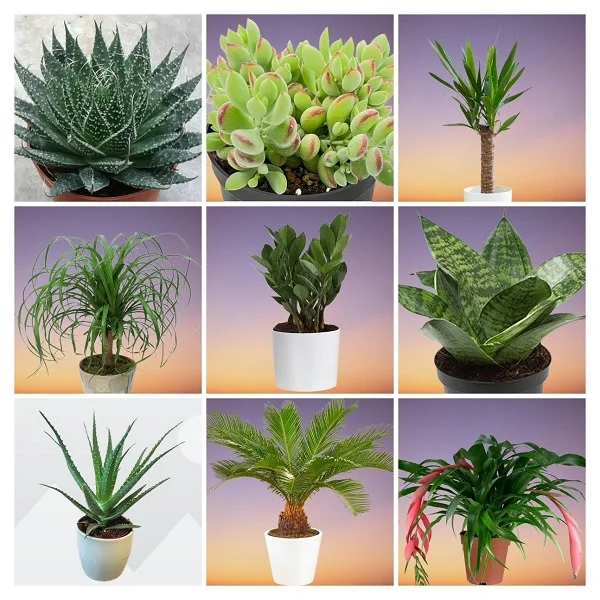Bougainvillea glabra (Paper Flower) Indoor Care, Propagation, Problems and Solutions
Some links in this post may be affiliate links
Bougainvillea glabra prospers in very bright light with some direct sunlight, average warmth, average humidity and moderately moist, fertile, well-drained soil coupled with fortnightly feeding in spring and summer.
Bougainvillea glabra commonly called Bougainvillea Plant or Paper Flower is one of the popular flowering plants which is grown for its showy blooms as a shrub or in a hanging basket where the trailing stems can be allowed to hang downwards.
There are hundreds of Bougainvillea plants grown for their showy blooms but Bougainvillea glabra is the one commonly grown as a houseplant.
Paper Flower is an evergreen, climbing shrub with thorny stems which can be trained into a bonsai or can also be allowed to climb up a trellis.

Botanical name: Bougainvillea glabra
Family: Nyctaginaceae
Common names: Bougainvillea Plant, Paper Flower
Origin
Bougainvillea glabra is native to Brazil.
Size
The trailing stems in Paper Flower can grow to 12 feet long if not pruned which places this plant among the best flowering plants for hanging baskets.
Flowers
The blooms in Bougainvillea are clusters of brightly colored papery bracts in pink, red, orange or purple surrounding small, creamy-white flowers.
Varieties
There are many hybrids of Bougainvillea to choose from. Most popular are the large-leaved, large-flowered Mrs Butt whose flowers are rose-crimson.
Other popular varieties are Magnifica which is purple, Raspberry Ice with ravish-red flowers, Alexendra which is pink and is a prolific bloomer, and Harissii whose variegated grey-green foliage is splashed with cream-white.
Is Bougainvillea poisonous?
No. Bougainvillea glabra is considered to be non-toxic to humans and pets. ASPCA has not listed them as toxic to pets. However, the stems bear thorns which can cause injury. Always wear gloves when handling the plants to protect yourself.
How to care for Bougainvillea glabra indoors
Caring for Bougainvillea glabra indoors, entails giving it very bright light with 4-6 hours of sunlight, average warmth of 16-270C, humidity of 50-55% and moderately moist, fertile, well-drained soil coupled with fortnightly feeding during the growing season.
Paper Flower Plant care needs frequent pruning to keep the plant neat, to minimize pest infestations, to encourage bushy growth and rejuvenate growth. Repotting is needed only when it becomes pot-bound. Keep on reading for more on these growing conditions and how to achieve them.

Watering
How often shoul I water a Bougainvillea?
Water your Bougainvillea liberally in spring and summer and allow the top 2-3 inches of soil to dry out between waterings. Keep the soil moderately moist and avoid overwatering to prevent yellowing and leaf drop.
Decrease watering in fall and winter as growth is minimal at this time. However, do not allow the soil to dry out completely to prevent wilting and leaf fall.
Use water that is at room temperature to prevent cold shock as it can result in stunted growth and leaf loss. Avoid chlorinated water; use rain water or filtered water to prevent browning of leaf edges.
Ascertain that the pot has a drainage hole and the soil is well-draining to prevent waterlogging which can lead to root-rot and death of the plant.
Light Requirements
Bougainvillea grows best in very bright light with 4-6 hours of morning or late afternoon sunshine. Keep it away from hot midday sunlight to avoid scorching; brown leaf marks.
Ensure the plant receives enough light as it will not bloom if the light is too low. Therefore, where natural lighting is inadequate, use full spectrum grow lights to supplement.
Regularly rotate the pot to ensure that the plant receives light from all sides for an even growth and prevent leggy growth.
Paper Flower can also be grown outdoors under direct sunlight but it needs to be acclimated to these conditions gradually by exposing it to brighter light every day for a period of 2 weeks. It is one of the sun-loving plants for the home.
Temperature and Humidity
Bougainvillea thrives in an average warmth of 16-270C. Keep it away from sources of drafts like AC units, windy doors, drafty windows, stoves, hot air vents and others to prevent sudden changes in temperature which can cause stunted growth and leaf drop.
Paper Flower prefers a humidity of 50-55%. However, if the air is too dry, set the pot on a wet pebble tray, use a cool mist humidifier or group the plants together to raise humidity. Maintain proper air flow to discourage fungal diseases.
Fertilizer
What is the best fertilizer for Bougainvillea?
Feed Bougainvillea with a balanced, liquid fertilizer every 2-3 weeks in spring and summer to promote a lush, healthy growth. Withhold feeding in fall and winter as growth is reduced, therefore, feeding at this time can lead to fertilizer burn as the plant does not need it.
Occasionally, leach out excess salts by drenching the soil with plenty of water and let it drain freely through the drainage hole. Repeat the process several times to clear as much salt as possible.
Potting Soil
What kind of soil does Bougainvillea like?
Bougainvillea likes a rich, loose, free-draining soil to prevent waterlogging while providing the required nutrients. A mix of 2 parts all purpose soil and 1 part perlite or vermiculite (for drainage) is ideal for this plant.
Repotting
Repot Bougainvillea in the beginning of the growing season (spring to early summer), only if the plant is extremely root-bound as it blooms more when pot-bound.
Do not repot a plant that is in flower as doing so will shock the plant resulting in a short flowering period.
Select a pot 1 size larger and one that has a drainage hole and well-draining soil to prevent waterlogging as it can lead to root-rot and death of the plant. Check out these Flower Pots with Multi Mesh Drainage Holes on Amazon.
For the large plants which may be difficult to repot you can top-dress annually by replacing the top 3-4 inches of soil with fresh soil.
Take care not to expose the roots to dry air while repotting. Keep the roots moist by covering them with a wet towel or by ensuring there is a ball of soil around them.
Pruning
How to pruning Bougainvillea
Pruning Bougainvillea is easy:
- Remove dead flowers and leaves to maintain the plant neat and discourage pest infestations.
- Pinch off the growing tips to encourage a bushy, compact growth and prevent the plant from getting unruly.
- After flowering, lightly cutback the stems to encourage new growth and blooming as well as prevent legginess. Place the plant in a cool place and reduce watering until new growth emerges.
Bougainvillea Propagation
Bougainvillea glabra is best propagated at the beginning of the growing season from stem-tip cuttings.
Propagating Bougainvillea from stem-tip cuttings
- Take 4-6 inches stem-tip cuttings from a healthy plant. Make sure they have at least 2-3 leaf nodes as this is where new growth will come from.
- Strip off the lower leaves from the cuttings and coat the lower part of the stem with a rooting hormone to encourage rooting.
- Fill small pots with a free-draining soil and slightly moisten it. Confirm that the pots have drainage holes to prevent rotting.
- Carefully insert 1-2 inches the coated cuttings in the moist soil while taking care not to rub off the rooting hormone.
- Place the set up in a warm, well-lit spot away from direct sunlight to prevent scorching.
- Maintain the soil moist until the cuttings are rooted and well established.
- Once well established, transplant the new plant into a pot one size larger after which you can begin routine.

Bougainvillea glabra Problems & Remedies
Paper Flower problems include yellow leaves, lack of blooms, leaf drop, wilting leaves, pests and diseases. Keep reading for more on these problems and how to fix them.
Yellow leaves
Some of the causes of yellow leaves on Bougainvillea are too little light, inconsistent watering, soggy soil, nutrient deficiency, and temperature stress.
How to fix it
Too little light: Move the plant to a brighter spot or instal a grow light if the natural light is not enough.
Inconsistent watering: Do not water on a schedule. Water only when the top 2-3 inches of soil dry out.
Soggy soil: Use a well-draining soil and a pot that has a drainage hole.
Nutrients deficiency: Apply a balanced, water-soluble fertilizer every 2-3 weeks in spring and summer.
Temperature stress: Keep the plant away from drafts coming from hot surfaces, hot air vents, AC units, windy doors among others.
Lack of blooms
Lack of blooms on Bougainvillea is caused by too little light, nutrients deficiency, drafts, inconsistent watering, soggy soil or lack of pruning.
How to fix it
Too little light: Move the plant to a brighter spot with at least 4-6 hours of direct sunlight or instal a grow light if the natural lighting is not adequate.
Nutrients deficiency: Feed the plant every 2-3 weeks with a balanced, liquid fertilizer in spring and summer.
Drafts: Keep the plant away from sources of drafts like AC units, drafty windows, hot air vents, windy doors and others.
Inconsistent watering: Do not water on a schedule. Water when the top 2-3 inches of soil feel dry but do not allow the soil to dry out completely.
Soggy soil: Use a a pot that has a drainage hole and well-draining soil.
Lack of pruning: Cutback the stems after flowering to encourage new growth and promote flowering.
Leaf drop
Leaf drop on Paper Flower is caused by too little light, drafts, and inconsistent watering.
How to fix it
Too little light: Move the plant to a brighter spot or instal a grow light if the natural light is not enough.
Drafts: Keep it away from sources of drafts like AC units, drafty windows, hot air vents, windy doors and others.
Inconsistent watering: Do not water on a schedule. Water when the top 2-3 inches of soil feel dry but do not allow the soil to dry out completely.
Wilting leaves
Wilting leaves on Bougainvillea are caused by dry air, incorrect watering, soggy soil, being extremely pot-bound or pests infestations.
How to fix it
Dry air: To increase humidity, set the pot on a wet pebble tray, use a humidifier or group the plants together.
Incorrect watering: Water when the top 2-3 inches dry out but do not allow the soil to dry out completely.
Soggy soil: Ensure that the soil is free-draining and that the pot has a drainage hole.
Being extremely pot-bound: Look out for roots growing through the drainage hole and repot the plant into a pot one size larger than the current one.
Pests infestations: Regularly check underneath the leaves for these pests and carry out timely control measures.
Pests
Common pests on Bougainvillea are spider mites and aphids.
How to fix it
- Regularly inspect the plant for pests and take timely control measures.
- Isolate the affected plant to prevent spread to other plants.
- Treat the affected plant with neem oil or insecticidal soap as per the manufacturers' recommendations.
- Regularly damp-wipe the leaves with a soft cloth to discourage the pests.
- Keep the plant well pruned to remove the hiding and breeding places for these pests.
Diseases
Bougainvillea is prone to root-rot which is enhanced by soggy soil. The disease is characterized by yellowing and wilting leaves, rapidly followed by browning and plant collapse.
How to fix it
- Carefully slip the plant out of its pot and inspect the roots.
- Trim the brown-black, mushy roots and treat the healthy roots with a copper-based fungicidal solution as recommended by the manufacturer.
- Disinfect the pot with the fungicidal solution or use a fresh pot to repot the plant in fresh, well-draining soil.
- Do not water the plant immediately; keep it dry for 5-7 days before you can resume watering.
- Use a pot with a drainage hole and well-draining soil to prevent the soil from getting soggy.
- Reduce watering in fall and winter as growth is reduced at this time to keep the soil slightly moist.
You liked it? Share on social media.
Related Content
Amazon Associates Disclosure
Homeplantsguide.com is a participant in the Amazon Services LLC Associates Program, an affiliate advertising program designed to provide a means for sites to earn advertising fees by advertising and linking to amazon.com.





